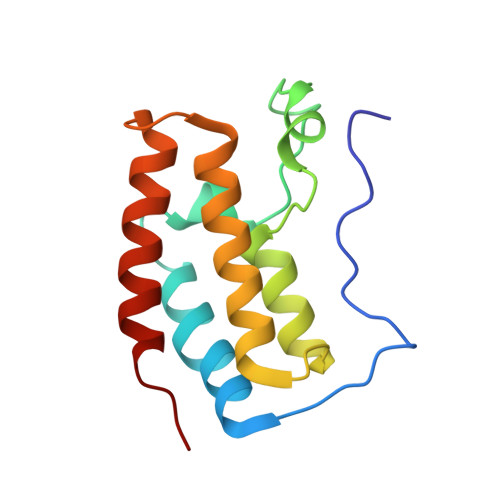Fragment-based drug discovery of 2-thiazolidinones as BRD4 inhibitors: 2. Structure-based optimization
Zhao, L., Wang, Y., Cao, D.Y., Chen, T.T., Wang, Q., Li, Y., Xu, Y.C., Zhang, N., Wang, X., Chen, D., Chen, L., Chen, Y.L., Xia, G., Shi, Z., Liu, Y.C., Lin, Y., Miao, Z., Shen, J., Xiong, B.(2015) J Med Chem 58: 1281-1297
- PubMed: 25559428
- DOI: https://doi.org/10.1021/jm501504k
- Primary Citation of Related Structures:
4QR3, 4QR4, 4QR5 - PubMed Abstract:
The signal transduction of acetylated histone can be processed through a recognition module, bromodomain. Several inhibitors targeting BRD4, one of the bromodomain members, are in clinical trials as anticancer drugs. Hereby, we report our efforts on discovery and optimization of a new series of 2-thiazolidinones as BRD4 inhibitors along our previous study. In this work, guided by crystal structure analysis, we reversed the sulfonamide group and identified a new binding mode. A structure-activity relationship study on this new series led to several potent BRD4 inhibitors with IC50 of about 0.05-0.1 μM in FP binding assay and GI50 of 0.1-0.3 μM in cell based assays. To complete the lead-like assessment of this series, we further checked its effects on BRD4 downstream protein c-Myc, investigated its selectivity among five different bromodomain proteins, as well as the metabolic stability test, and reinforced the utility of 2-thiazolidinone scaffold as BET bromodomain inhibitors in novel anticancer drug development.
Organizational Affiliation:
Department of Medicinal Chemistry, State Key Laboratory of Drug Research, Shanghai Institute of Materia Medica, ‡Division of Anti-Tumor Pharmacology, State Key Laboratory of Drug Research, Shanghai Institute of Materia Medica, and §Drug Discovery and Design Center, Shanghai Institute of Materia Medica, Chinese Academy of Sciences , 555 Zuchongzhi Road, Shanghai 201203, China.















